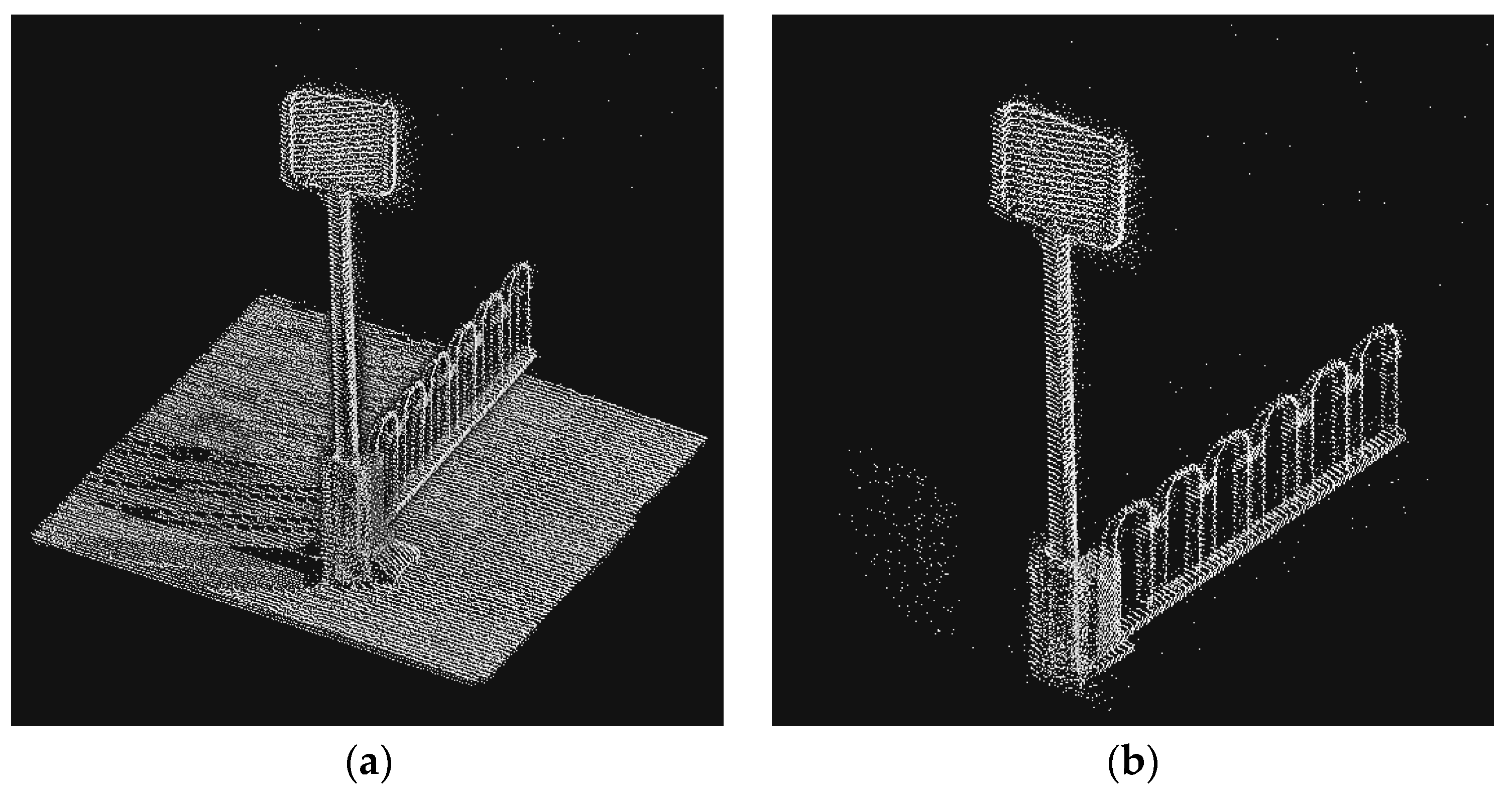Extracting Traffic Signage by Combining Point Clouds and Images
Abstract
1. Introduction
2. Traffic Sign Detection
2.1. Improved Yolo Network
2.1.1. Convolutional Block Attention Module
2.1.2. K-Means
2.1.3. Modified Loss Function
2.2. Detection Result
2.2.1. Experimental Data
2.2.2. Refine Results
3. Traffic Sign Positioning Extraction
3.1. Image Coordinate Transfer to Point Cloud
3.1.1. Obtaining Depth Map
3.1.2. Image Projection to Point Cloud
3.2. Region of Interest Extraction
3.3. Refined Extraction
3.3.1. Ground Points Removal
3.3.2. Regional Growth Clustering
3.3.3. Intensity Filtering and RANSAC Planar Fitting
3.4. Dimensional Feature
3.4.1. Calculating Eigenvalues
3.4.2. Dimensional Analysis
4. Discussion
4.1. Accuracy Analysis
4.2. Visual Analysis
5. Conclusions and Future Research Directions
Author Contributions
Funding
Data Availability Statement
Conflicts of Interest
References
- Meuter, M.; Nunn, C.; Gormer, S.M.; Muller-Schneiders, S.; Kummert, A. A Decision Fusion and Reasoning Module for a Traffic Sign Recognition System. IEEE T Intell. Transp. 2011, 12, 1126–1134. [Google Scholar] [CrossRef]
- Ren, F.X.; Huang, J.; Jiang, R.; Klette, R. General Traffic Sign Recognition by Feature Matching. In Proceedings of the Image & Vision Computing New Zealand, Ivcnz 09 International Conference, Queenstown, New Zealand, 12 January 2010. [Google Scholar]
- Chiang, H.H.; Chen, Y.L.; Wang, W.Q.; Lee, T.-T. Road speed sign recognition using edge-voting principle and learning vector quantization network. In Proceedings of the Computer Symposium (ICS), 2010 International, Tainan, Taiwan, 18 January 2011. [Google Scholar]
- Piccioli, G. Robust method for road sign detection and recognition. Imavis 1996, 14, 209–223. [Google Scholar] [CrossRef]
- Mclaughlin, R.A.; Alder, M.D. The Hough transform versus the UpWrite. IEEE T-Pami 1998, 20, 396–400. [Google Scholar] [CrossRef]
- Barnes, N.; Zelinsky, A.; Fletcher, L.S. Real-Time Speed Sign Detection Using the Radial Symmetry Detector. IEEE T Intell. Transp. 2016, 9, 322–332. [Google Scholar] [CrossRef]
- Wang, Y.; Shi, M.; Tao, W. A Method of Fast and Robust for Traffic Sign Recognition. In Proceedings of the International Conference on Image & Graphics, Xi’an, China, 21 September 2009. [Google Scholar]
- Qian, R.; Zhang, B.; Yue, Y.; Coenen, F. Traffic sign detection by template matching based on multi-level chain code histogram. In Proceedings of the International Conference on Fuzzy Systems & Knowledge Discovery, Zhangjiajie, China, 15 August 2015. [Google Scholar]
- Creusen, I.M.; Wijnhoven, R.; Herbschleb, E.; de With, P.H.N. Color exploitation in hog-based traffic sign detection. In Proceedings of the IEEE International Conference on Image Processing, Manila, Philippines, 3 December 2010. [Google Scholar]
- Houben, S. A single target voting scheme for traffic sign detection. In Proceedings of the Intelligent Vehicles Symposium, Baden, Germany, 1 June 2011. [Google Scholar]
- Kuo, W.J.; Lin, C.C. Two-Stage Road Sign Detection and Recognition. In Proceedings of the IEEE International Conference on Multimedia & Expo, Beijing, China, 2–5 July 2007. [Google Scholar]
- Maldonado-Bascon, S.; Lafuente-Arroyo, S.; Gil-Jimenez, P.; Gomez-Moreno, H.; Lopez-Ferreras, F. Road-Sign Detection and Recognition Based on Support Vector Machines. IEEE T Intell. Transp. 2007, 8, 64–278. [Google Scholar] [CrossRef]
- Stallkamp, J.; Schlipsing, M.; Salmen, J.; Igel, C. Man vs. computer: Benchmarking machine learning algorithms for traffic sign recognition. Neural Netw. Off. J. Int. Neural Netw. Soc. 2012, 32, 323–332. [Google Scholar] [CrossRef] [PubMed]
- Boi, F.; Gagliardini, L. A Support Vector Machines network for traffic sign recognition. In Proceedings of the The 2011 International Joint Conference on Neural Networks, San Jose, CA, USA, 31 July–5 August 2011. [Google Scholar]
- Redmon, J.; Farhadi, A. Yolo9000: Better, Faster, Stronger. In Proceedings of the 2017 IEEE Conference on Computer Vision and Pattern Recognition (CVPR), Honolulu, HI, USA, 21–26 July 2017. [Google Scholar]
- Leibe, B.; Matas, J.; Sebe, N.; Wei, L.; Dragomir, A.; Dumitru, E.; Christian, S.; Scott, R.; Cheng-Yang, F. [Lecture Notes in Computer Science] Computer Vision. Single Shot MultiBox Detect. 2016, 9905, 21–37. [Google Scholar]
- Girshick, R.; Donahue, J.; Darrell, T.; Malik, J. Rich Feature Hierarchies for Accurate Object Detection and Semantic Segmentation. In Proceedings of the IEEE 2014 IEEE Conference on Computer Vision and Pattern Recognition (CVPR), Columbus, OH, USA, 23–28 June 2014. [Google Scholar]
- Ren, S.; He, K.; Girshick, R.; Sun, J. Faster R-CNN: Towards Real-Time Object Detection with Region Proposal Networks. In Proceedings of the NIPS, Barcelona, Spain, 1 January 2016. [Google Scholar]
- Ciresan, D.; Meier, U.; Masci, J. Multi-column deep neural network for traffic sign classification. Neural Netw. 2012, 32, 333–338. [Google Scholar] [CrossRef] [PubMed]
- Dan, C.; Meier, U.; Masci, J.; Schmidhuber, J. A committee of neural networks for traffic sign classification. In Proceedings of the 2011 International Joint Conference, San Jose, CA, USA, 31 July–5 August 2011. [Google Scholar]
- Rehman, Y.; Khan, J.A.; Shin, H. Efficient coars- er-to-fine holistic traffic sign detection for occlusion handling. IET Image Process. 2018, 12. [Google Scholar] [CrossRef]
- Debeunne, C.; Vivet, D. A Review of Visual-LiDAR Fusion based Simultaneous Localization and Mapping. Sensors 2020, 20, 2068. [Google Scholar] [CrossRef] [PubMed]
- Yu, X.; Marinov, M. A Study on Recent Developments and Issues with Obstacle Detection Systems for Automated Vehicles. Sustainability 2020, 12, 3281. [Google Scholar] [CrossRef]
- Lopac, N.; Jurdana, I.; Brnelíc, A.; Krljan, T. Application of Laser Systems for Detection and Ranging in the Modern Road Transportation and Maritime Sector. Sensors 2022, 22, 5946. [Google Scholar] [CrossRef] [PubMed]
- Zhou, L.; Deng, Z. LIDAR and Vision-Based Real-Time Traffic Sign Detection and Recognition Algorithm for Intelligent Vehicle. In Proceedings of the 17th International IEEE Conference on Intelligent Transportation Systems III, Qingdao, China, 8–11 October 2014; Volume 6. [Google Scholar]
- Yokoyama, H.; Date, H.; Kanai, S.; Takeda, H. Pole-like objects recognition from mobile laser scanning data using smoothing and principal component analysis. ISPRS Int. Arch. Photogramm. Remote Sens. Spat. Inf. Sci. 2012, 38, 115–120. [Google Scholar] [CrossRef]
- Laflamme, C. Automated Asset Detection, Location Measurement and Recognition. U.S. Patent 7,623,248, 24 November 2009. [Google Scholar]
- Ai, C.; Tsai, Y.J. Critical Assessment of Automatic Traffic Sign Detection Using Three-Dimensional LiDAR Point Cloud Data. In Proceedings of the Transportation Research Board 91st Annual Meeting, Washington, DC, USA, 22–26 January 2012. [Google Scholar]
- Yu, Y.; Li, J.; Guan, H.; Jia, F.; Wang, C. Three-Dimensional Object Matching in Mobile Laser Scanning Point Clouds. IEEE Geosci. Remote Sens. Lett. 2014, 12, 492–496. [Google Scholar]
- Vu, A.; Yang, Q.; Farrell, J.A.; Barth, M. Traffic sign detection, state estimation, and identification using onboard sensors. In Proceedings of the International IEEE Conference on Intelligent Transportation Systems, The Hague, The Netherlands, 6–9 October 2013. [Google Scholar]
- Qi, C.R.; Su, H.; Mo, K.; Guibas, L.J. PointNet: Deep Learning on Point Sets for 3D Classification and Segmentation. In Proceedings of the 2017 IEEE Conference on Computer Vision and Pattern Recognition (CVPR), Honolulu, HI, USA, 21–26 July 2017. [Google Scholar]
- Li, Y.; Bu, R.; Sun, M.; Chen, B. PointCNN[C]. arXiv 2018, arXiv:1801.07791. [Google Scholar]
- Qi, C.R.; Wei, L.; Wu, C.; Su, H.; Guibas, L.J. Frustum PointNets for 3D Object Detection from RGB-D Data. In Proceedings of the 2018 IEEE/CVF Conference on Computer Vision and Pattern Recognition, Lake City, UT, USA, 18–23 June 2018. [Google Scholar]
- Redmon, J.; Farhadi, A. Yolov3: An Incremental Improvement. arXiv 2018, arXiv:1804.02767. [Google Scholar]
- Woo, S.; Park, J.; Lee, J.Y.; Kweon, I.S. CBAM:convolutional block attention module. In Proceedings of the The European Conference on Computer Vision, Munich, Germany, 8 September 2018. [Google Scholar]
- Rezatofighi, H.; Tsoi, N.; Gwak, J.Y.; Sadeghian, A.; Reid, I.; Savarese, S. Generalized Intersection Over Union: A Metric and a Loss for Bounding Box Regression. In Proceedings of the 2019 IEEE/CVF Conference on Computer Vision and Pattern Recognition (CVPR), IEEE, Long Beach, CA, USA, 15–20 June 2019. [Google Scholar]
- Zhang, W.; Qi, J.; Wan, P.; Wang, H.; Xie, D.; Wang, X.; Yan, D. An Easy-to-Use Airborne LiDAR Data Filtering Method Based on Cloth Simulation. Remote Sens. 2016, 8, 501. [Google Scholar] [CrossRef]
- Sato, M.; Lakare, S.; Ming, W.; Kaufman, A.; Nakajima, M. A gradient magnitude based region growing algorithm for accurate segmentation. In Proceedings of the 2000 International Conference on Image Processing (Cat. No.00CH37101), Vancouver, BC, Canada, 10–13 September 2000. [Google Scholar]
- Fischler, M.A.; Bolles, R.C. Random Sample Consensus: A Paradigm for Model Fitting with Applications To Image Analysis and Automated Cartography. Commun. ACM 1981, 24, 381–395. [Google Scholar] [CrossRef]

















| Category | Before Balance | After the Balance |
|---|---|---|
| Prohibition signs | 18,317 | 18,317 |
| Indicator signs | 4989 | 7631 |
| Warning Signs | 1396 | 5317 |
| Accuracy (%) | Overall Accuracy (%) | Recall Rate (%) | |||
|---|---|---|---|---|---|
| Prohibited Signs | Indicator Signs | Warning Signs | |||
| Yolov3 | 84.7 | 81.9 | 79.3 | 82.0 | 86.3 |
| Ours | 86.3 | 83.7 | 80.2 | 83.4 | 88.1 |
| Method | Accuracy (%) | Recall Rate (%) |
|---|---|---|
| Extraction method based on reflection intensity | 7.5 | 28.6 |
| RANSAC-based extraction method | 2.8 | 12.9 |
| Combined Image + Reflection Intensity | 76.3 | 94.7 |
| Combined Imaging + RANSAC | 87.6 | 94.7 |
| Methodology of this article | 97.8 | 94.7 |
Disclaimer/Publisher’s Note: The statements, opinions and data contained in all publications are solely those of the individual author(s) and contributor(s) and not of MDPI and/or the editor(s). MDPI and/or the editor(s) disclaim responsibility for any injury to people or property resulting from any ideas, methods, instructions or products referred to in the content. |
© 2023 by the authors. Licensee MDPI, Basel, Switzerland. This article is an open access article distributed under the terms and conditions of the Creative Commons Attribution (CC BY) license (https://creativecommons.org/licenses/by/4.0/).
Share and Cite
Zhang, F.; Zhang, J.; Xu, Z.; Tang, J.; Jiang, P.; Zhong, R. Extracting Traffic Signage by Combining Point Clouds and Images. Sensors 2023, 23, 2262. https://doi.org/10.3390/s23042262
Zhang F, Zhang J, Xu Z, Tang J, Jiang P, Zhong R. Extracting Traffic Signage by Combining Point Clouds and Images. Sensors. 2023; 23(4):2262. https://doi.org/10.3390/s23042262
Chicago/Turabian StyleZhang, Furao, Jianan Zhang, Zhihong Xu, Jie Tang, Peiyu Jiang, and Ruofei Zhong. 2023. "Extracting Traffic Signage by Combining Point Clouds and Images" Sensors 23, no. 4: 2262. https://doi.org/10.3390/s23042262
APA StyleZhang, F., Zhang, J., Xu, Z., Tang, J., Jiang, P., & Zhong, R. (2023). Extracting Traffic Signage by Combining Point Clouds and Images. Sensors, 23(4), 2262. https://doi.org/10.3390/s23042262






